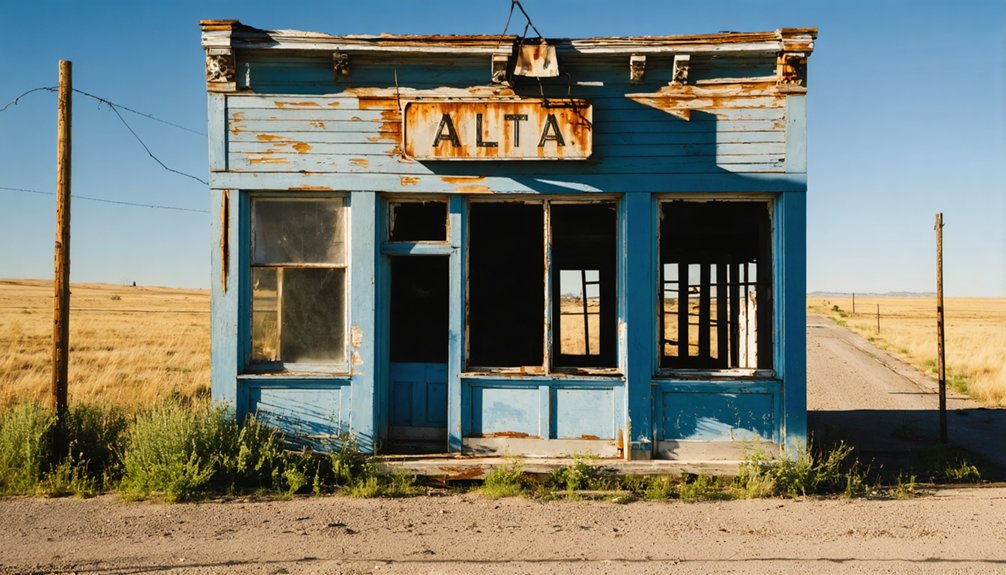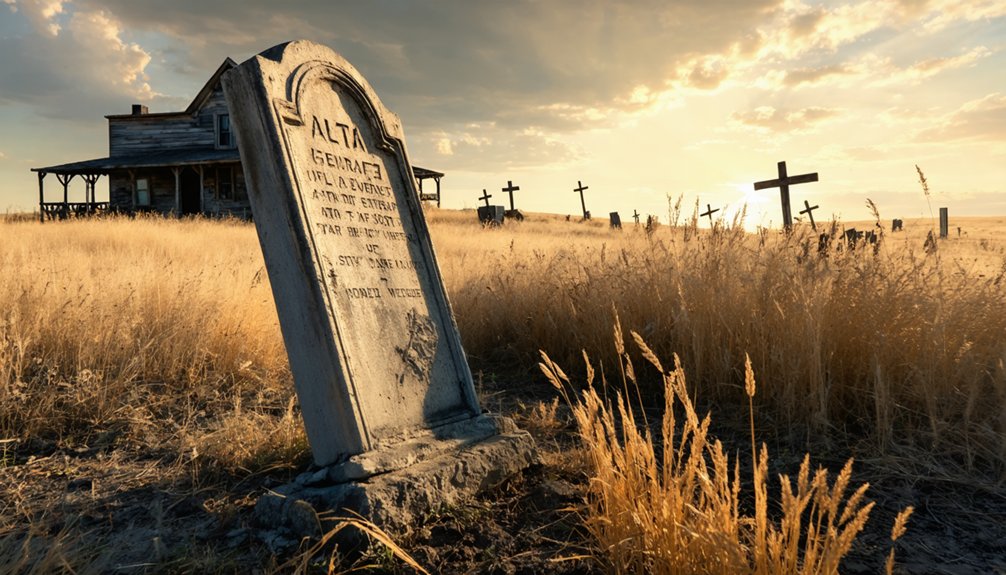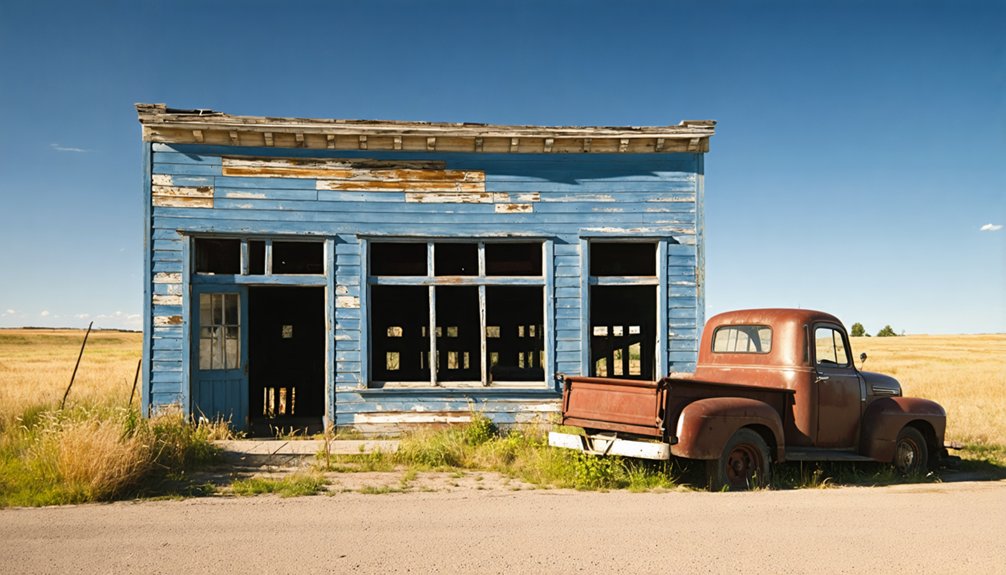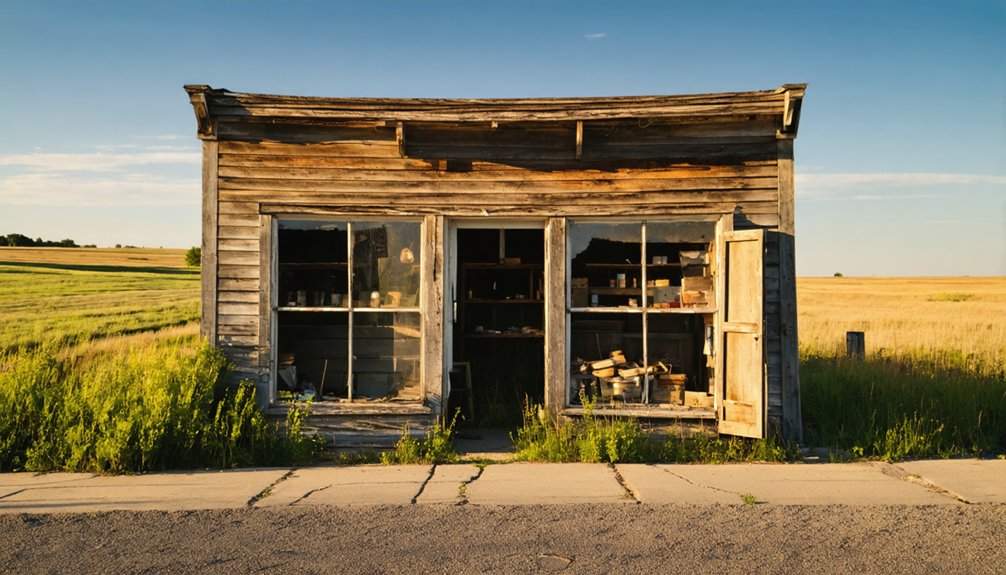In Alta, South Dakota’s Black Hills, you’ll discover the haunting remains of an 1870s gold rush settlement that once bustled with railroad workers and sawmill employees. The town flourished as an essential transportation hub until changing rail routes sealed its fate. Today, you can explore weathered foundations, a historic cemetery with pioneer graves, and architectural remnants that hint at Alta’s industrial heritage. The echoes of this former boomtown hold fascinating tales of frontier life and survival.
Key Takeaways
- Alta emerged as a Black Hills mining settlement in the 1870s during the gold rush, established on traditional Lakota Sioux territory.
- The town served as a transportation hub with around 100 residents working primarily in railroad operations and sawmill industries.
- Economic decline began when railroad lines bypassed Alta, leading to business relocations and eventual abandonment of the settlement.
- Architectural remains include weathered wooden structures, stone foundations, and frontier-era buildings reflecting late 1800s Dakota Territory construction.
- The town’s cemetery contains markers of miners, children, and settlers, while preservation efforts document Alta’s pioneer heritage.
The Rise of a Black Hills Settlement
While Native Americans had inhabited the Black Hills for millennia, Alta’s story began during the transformative Black Hills Gold Rush of the 1870s.
You’ll find that Alta emerged during a controversial period of settlement expansion, when miners flooded into territory that legally belonged to the Lakota Sioux under the Fort Laramie Treaty of 1868.
The town’s establishment came at the expense of profound cultural significance to the Lakota people, who knew these sacred lands as Paha Sapa. The Black Hills represents the oldest mountain range in the United States, spanning an impressive 125 miles long and 65 miles wide.
The area’s rugged landscape features dense pine forests and impressive geological formations that attracted early settlers.
As prospectors and settlers defied treaty obligations in their pursuit of gold, the U.S. government ultimately seized the Black Hills through the illegal Manypenny Agreement of 1877.
This seizure marked a pivotal moment in the region’s history, fundamentally altering both the physical and cultural landscape of the Black Hills forever.
Railroad Legacy and Industrial Roots
You’ll find Alta’s development was inextricably linked to the Black Hills railroad expansion of the 1880s, when companies like the Fremont, Elkhorn and Missouri Valley Railroad transformed mining settlements into essential transportation hubs.
The railroads’ strategic control over town placement and land development meant Alta’s location and growth were directly shaped by rail industry decisions, particularly as narrow-gauge lines connected the region’s mining operations. Local speculators invested heavily in the surrounding land, anticipating significant returns from the railroad’s arrival. The discovery of gold in 1874 by the Custer Expedition had set this entire development process in motion.
Today, the remaining railroad infrastructure around Alta stands as evidence to the transformative role these rail networks played in the Black Hills’ industrial evolution.
Rail Operations Impact Settlement
As rail lines stretched across South Dakota during the Great Dakota Boom of 1878-1887, Alta emerged as one of many settlements whose existence hinged on the transformative power of railroad development.
You’ll find that railroad migration shaped the town’s very foundation, with more than 169 track miles enabling farms and communities to flourish across the region.
The railroad’s influence on Alta’s economic viability proved decisive. When trains arrived, they brought essential supplies absent from the local landscape – fuel, building materials, and fencing. Like many other towns during this era, Alta followed a T-shaped layout pattern with its commercial avenue running perpendicular to the tracks.
This lifeline transformed Alta into a transportation hub, where grain elevators and loading docks sprang up alongside the tracks. The depot became more than just a stop; it evolved into the heart of community life, fostering both industrial growth and social connections that defined the town’s character. The simple boxcar structures that initially served as depots reflected the modest beginnings of these railroad communities.
Historic Transportation Hub Remains
The remnants of Alta’s industrial core still hint at its heyday as a pivotal Black Hills transportation hub. When you explore this ghost town today, you’ll find traces of the narrow-gauge rail infrastructure that once connected Alta to the region’s thriving mining and agricultural operations.
The town’s transportation significance stemmed from its strategic position within the railroad networks that crisscrossed southeastern Dakota Territory in the 1880s.
As you wander through Alta’s remains, you’ll notice how the town’s layout reflects the calculated planning of railroad interests – from the strategic placement of loading zones to the grid pattern designed for maximum rail efficiency.
These industrial artifacts tell the story of a once-bustling hub where trains carried essential cargo, connecting local enterprises to broader markets across the Black Hills.
Daily Life in Alta’s Golden Years
During Alta’s peak years, life in this small South Dakota town centered around its 100-strong community of railroad workers, sawmill employees, and their families.
Alta thrived as a close-knit railroad and sawmill community, where 100 residents built their lives in rural South Dakota.
You’d find daily routines revolved around labor-intensive work at the sawmill or railroad, with farmers and merchants supporting the town’s basic needs.
The local chapel served as the heart of community gatherings, where you’d join your neighbors for religious services and social events.
Life wasn’t easy – you’d face harsh winters and frequent flooding that tested the resilience of your modest wood-frame home.
Medical care required traveling to larger towns, and the 1919 influenza outbreak hit families hard.
Despite these challenges, you’d find strength in the close-knit relationships formed through shared meals, church meetings, and the mutual support of your fellow townspeople.
Like many South Dakota towns, Alta was established every seven miles along the railroad to service steam locomotives.
As transportation methods evolved, the decline of railway shipping and rise of truck transport contributed to Alta’s eventual abandonment.
Economic Forces Behind the Exodus
While multiple factors contributed to Alta’s eventual abandonment, railroad economics played the decisive role in sealing the town’s fate. When rail lines bypassed Alta in favor of more strategic locations, you would’ve witnessed the town’s rapid economic isolation.
Similar to the fate of Ordway’s Methodist university, ambitious development plans were abandoned as the town’s prospects dimmed.
Local businesses, once thriving on railroad commerce, relocated to better-connected areas, triggering a devastating population decline. Like the pattern seen in Trojan, residents were forced to move to larger towns like Lead and Deadwood for employment opportunities.
The town’s inability to attract alternative industries proved fatal. You’d have seen how changes in agricultural practices, including mechanization and the consolidation of family farms, further eroded Alta’s economic foundation.
The closure of essential services like the post office and supply stores created a downward spiral. Without rail connectivity or a diversified economy, Alta couldn’t sustain itself, and residents gradually moved to more prosperous communities with better opportunities.
Architectural Remnants and Time’s Touch

You’ll find Alta’s architectural legacy written in its weathered wooden structures and stone foundations, which have endured decades of harsh South Dakota winters and scorching summers.
The town’s railroad heritage survives through crumbling granite block foundations that once supported the Burlington Northern line’s infrastructure, including a section house and water tower footprint.
The frontier-era buildings showcase typical late 1800s Dakota Territory construction techniques, with locally-quarried stone bases supporting timber frames that now lean and sag under nature’s persistent touch.
Weathered Wood and Stone
Time’s relentless hand has sculpted Alta’s architectural remnants into a haunting tribute of mountain decay.
You’ll find weathered structures that tell the story of over a century’s battle with harsh elements – wood surfaces turned silver-gray, their grain patterns raised and splintered from countless freeze-thaw cycles.
The native sandstone foundations, while more resilient, bear their own scars of natural reclamation. Mortar joints have crumbled, leaving gaps where moss and lichen thrive.
Inside these mountain ruins, you’ll discover warped floorboards and sagging doorframes, while rusted hinges cling desperately to their posts.
Stone hearths stand as silent sentinels, though cracked and weathered, while windblown debris accumulates in corners where roofs have long since surrendered to time’s persistent assault.
Railroad Foundations Remain
Three distinct railroad grades slice through Alta’s abandoned landscape, their earthen scars still visible despite decades of neglect.
You’ll find evidence of railroad archaeology scattered throughout: depressions where wooden ties once lay, rusted spikes surfacing after spring rains, and crumbling loading dock foundations that hint at the town’s bustling past.
The economic decline that swept through South Dakota’s rail towns left these tangible reminders:
- Stone foundations of the freight warehouse, now mere outlines against prairie grass
- Weather-beaten grain elevators standing sentinel beside former sidings
- Worker housing remnants, their partial walls telling stories of Alta’s railroad era
Today, you’re witnessing history slowly returning to earth, as nature reclaims these physical traces of Alta’s railroad-dependent past.
Fading Frontier Architecture
South Dakota’s harsh elements have steadily eroded Alta’s architectural legacy, leaving behind a haunting collection of weathered structures that tell the story of frontier pragmatism.
You’ll find stark examples of fading craftsmanship in the warped wooden churches and crumbling grain elevators that once anchored this community. Simple designs and local materials reflect the practical mindset of Alta’s early settlers, while architectural nostalgia lives on in modest Gothic revival elements of the chapel ruins.
Nature now claims these remnants, with grasses and shrubs engulfing building foundations and partial brick walls.
Weather-beaten wooden jails, complete with rusted iron bars, stand as silent sentinels to frontier law enforcement, while deteriorating homesteads reveal the honest simplicity of early residential construction techniques.
Stories From the Cemetery Grounds

While many ghost town cemeteries have faded into obscurity, Alta’s burial ground tells poignant stories of life and death in a 19th-century Black Hills mining camp.
These grave narratives reveal the harsh realities faced by early settlers, from deadly mining accidents to disease outbreaks that claimed entire families.
You’ll discover haunting reminders of frontier life through:
- Weather-worn markers bearing evidence to those who perished in mine collapses and winter storms
- Small plots marking the final resting places of children taken by diphtheria
- Wooden crosses that once identified unknown miners, now slowly returning to earth
Like other Black Hills burial grounds, spectral encounters have been reported here – shadowy figures moving between graves and phantom sounds echoing across the peaceful grounds, connecting you to Alta’s mining legacy.
Preserving Alta’s Pioneer Heritage
Preserving Alta’s pioneer heritage requires a multifaceted approach spanning both physical conservation and meticulous historical documentation.
You’ll find the South Dakota State Historical Society leading efforts to safeguard remaining structures while recording stories that bring the town’s past to life.
Through community engagement, local historians work with descendants of former residents to collect oral histories and artifacts.
Local historians enlist community help to gather precious memories and items from Alta’s past through descendants of original settlers.
You can access these treasures through digital preservation initiatives, including virtual tours and online archives that make Alta’s history available worldwide.
Watson Parker’s research, along with publications like “Black Hills Ghost Towns,” provides you with extensive insights into pioneer life.
Whether you’re exploring stabilized ruins on-site or examining photographs in digital collections, you’re connecting with Alta’s rich legacy through carefully preserved historical materials.
Modern Tourism and Ghost Town Appeal

Today’s visitors to Alta experience an authentic ghost town setting that defies modern commercialization, offering a raw glimpse into South Dakota’s pioneering past.
You’ll find yourself among Lawrence County’s rich collection of abandoned settlements, where ghost town photography enthusiasts capture haunting scenes of the American frontier’s boom-and-bust legacy.
Unlike heavily commercialized tourist destinations, Alta maintains its authentic appeal through:
- Unstructured exploration opportunities that let you discover the site on your own terms
- A genuine abandoned atmosphere that hasn’t been sanitized for mass tourism
- Seasonal accessibility that creates unique visitor experiences throughout the May-to-October peak period
Despite tourism challenges in recent years, Alta’s raw authenticity continues to draw history buffs and adventurers seeking freedom from conventional tourist experiences, though you’ll need to be self-sufficient as amenities are minimal.
Alta’s Place in Black Hills History
As gold fever swept through the Black Hills in the mid-1870s, Alta emerged as one of numerous mining settlements that would reshape the region’s destiny.
You’ll find Alta’s story deeply woven into the cultural transformation that followed Custer’s 1874 expedition, when European American miners flooded into this contested territory.
Like its neighbors Deadwood and Lead, Alta’s development came at a profound cost to the Lakota people, whose sacred lands were seized despite existing treaties.
The town’s mining operations tapped into the region’s rich mineral veins, contributing to a dramatic shift from Indigenous territory to a bustling frontier economy.
While the nearby Homestake Mine grew into a powerhouse, Alta remained one of many smaller settlements that defined the Black Hills’ volatile mining era.
Frequently Asked Questions
Are There Any Dangerous Animals or Wildlife Regularly Spotted in Alta?
You’ll want to keep your eyes peeled for wildlife sightings of black bears, mountain lions, and coyotes in the area. Don’t forget those mighty bison roaming nearby—they’re not exactly cuddly creatures.
What Natural Disasters or Severe Weather Events Have Impacted Alta’s Structures?
You’ll find severe winter storms caused major structural damage, while flood damage from snowmelt and thunderstorms weakened foundations. Storm impacts included lightning strikes, which posed fire risks to wooden buildings.
Has Alta Ever Been Featured in Paranormal Investigations or Ghost Hunting Shows?
Though ghost towns often spark supernatural intrigue, you won’t find Alta featured in any ghost hunting shows or paranormal investigations – it’s been overlooked by media in favor of more accessible haunted locations.
Can Visitors Legally Take Artifacts or Souvenirs From Alta’s Abandoned Buildings?
You can’t legally remove artifacts from Alta’s buildings. Taking items risks serious legal ramifications and violates artifact preservation laws, whether on private or public land. Always photograph rather than collect souvenirs.
Are There Any Known Treasure or Valuable Items Lost in Alta?
You won’t find documented treasure hunts or major valuable relics specifically lost in Alta. While the Black Hills region has mining folklore, there’s no confirmed record of hidden treasures in this location.
References
- https://www.sdhspress.com/journal/south-dakota-history-2-2/some-black-hills-ghost-towns-and-their-origins/vol-02-no-2-some-black-hills-ghost-towns-and-their-origins.pdf
- https://www.youtube.com/watch?v=Glucs_Rq8Xs
- https://www.sdpb.org/rural-life-and-history/2023-08-21/some-black-hills-ghost-towns-and-their-origins
- https://www.powderhouselodge.com/black-hills-attractions/fun-attractions/ghost-towns-of-western-south-dakota/
- https://www.youtube.com/watch?v=_0WNYsFLSLA
- https://icatchshadows.com/okaton-and-cottonwood-a-photographic-visit-to-two-south-dakota-ghost-towns/
- https://www.legendsofamerica.com/south-dakota-ghost-towns/
- https://en.wikipedia.org/wiki/List_of_ghost_towns_in_South_Dakota
- https://www.1880town.com
- https://en.wikipedia.org/wiki/Seizure_of_the_Black_Hills



